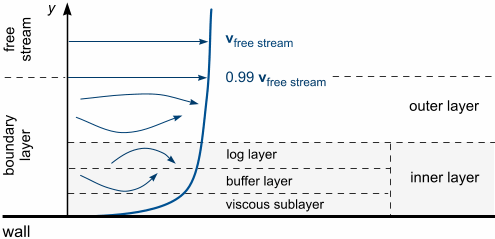Wall Treatment
Walls are a source of vorticity in most flow problems of practical importance. Therefore, an accurate prediction of the flow across the wall boundary layer is essential.
In fluid mechanics, the wall boundary layer describes the thin viscosity-affected layer near a wall in which the velocity of the flow changes from zero to the free stream value away from the wall. The nominal thickness of the boundary layer is defined as the normal distance from the wall to a point where the velocity is 99% of the free stream velocity. Beyond this point, effects of viscous stresses can be neglected.
The boundary layer flow can be either laminar or turbulent, depending on the Reynolds number of the flow. For low Reynolds numbers, the boundary layer is laminar and the streamwise velocity changes uniformly away from the wall. For high Reynolds numbers, the boundary layer is turbulent and the streamwise velocity is characterized by unsteady swirling flows inside the boundary layer.
The following diagram shows the velocity profile of a turbulent boundary layer:

The turbulent boundary layer is divided into two layers: the outer layer and the inner layer. The outer layer is dominated by turbulent effects. The inner layer is split up into three more sublayers. In each of the sublayers, the flow has different characteristics:
- Viscous Sublayer
The fluid layer in contact with the wall is dominated by viscous effects and is almost laminar. The mean flow velocity only depends on the fluid density, viscosity, distance from the wall, and the wall shear stress.
- Log Layer
The turbulent log layer is dominated equally by viscous and turbulent effects.
- Buffer Layer
The buffer layer is a transitional layer between the viscous sublayer and the log layer.
Each of the sublayers is modeled using different empirical approaches.
Laminar boundary layers require no specific modeling—the Equations of Fluid Flow describe the laminar flow field from the free stream down to the wall.
For turbulent boundary layers, no specific modeling is required if the exact governing equations of the flow are solved (Direct Numerical Simulation). However, when using a turbulence model, the physics of turbulent boundary layers must be modeled explicitly. The modeling approach usually includes two aspects:
- Near-Wall Turbulence Modeling
- The near-wall turbulence modeling deals with the local and non-local effect that walls have on turbulence in the viscosity-affected region (viscous sublayer and buffer layer), and is part of the turbulence model itself.
- Wall Treatment
- The wall treatment provides boundary conditions to the solvers for flow and energy. For RANS and DES turbulence models, the wall treatment provides boundary conditions to the solvers for turbulence and imposes values of the transported turbulence quantities on the centroids of the near-wall cells.
The choice of the wall-treatment usually depends on the near-wall turbulence modeling approach.